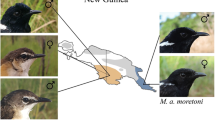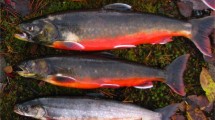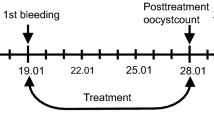Abstract
Models of parasite-mediated sexual selection propose that males with more elaborate sexual traits will have fewer parasites. These models have generally been tested using metazoan or protozoan parasites of the blood, gut, or integument. Fewer studies have examined sexual ornaments in relation to bacterial infections. While most surface bacteria are harmless or beneficial, feather-degrading bacteria may have detrimental effects. In this study, we examined the relationships between overall bacterial load, feather-degrading bacterial load, and sexually selected carotenoid-based plumage color in a wild population of house finches (Carpodacus mexicanus). We found that males with the redder plumage preferred by females had similar overall bacterial loads, but lower feather-degrading bacterial loads, than males with less red plumage. These data suggest that plumage color can signal abundance of feather-degrading bacteria to potential mates. It remains unclear whether feather-degrading bacteria directly or indirectly affect plumage color, but the observed correlations suggest that feather-degrading bacteria may play some role in sexual selection.

Similar content being viewed by others
References
Andersson M (1994) Sexual Selection. Princeton University Press, Princeton
Ballentine B, Hill GE (2003) Female mate choice in relation to structural plumage coloration in Blue Grosbeaks. Condor 105:593–598
Bennett ATD, Cuthill IC, Norris KJ (1994) Sexual selection and the mismeasure of color. Am Nat 144:848–860
Bockle B, Galunsky B, Muller R (1995) Characterization of a keratinolytic serine proteinase from Streptomyces pactum DSM 40530. Appl Environ Microbiol 61:3705–3710
Borgia G (1986) Satin bowerbird parasites: a test of the bright male hypothesis. Behav Ecol Sociobiol 19:355–358
Brawner WR, Hill GE, Sundermann CA (2000) Effects of coccidial and mycoplasmal infections on carotenoid-based plumage pigmentation in male house finches. Auk 117:952–963
Burtt E Jr, Ichida J (1999) Occurrence of feather-degrading Bacilli in the plumage of birds. Auk 116:364–372
Clayton D (1999) Feather-busting bacteria. Auk 116:302–304
Cristol DA, Armstrong JL, Whitaker JM, Forsyth MH (2005) Feather-degrading bacteria do not affect feathers on captive birds. Auk 123:222–230
El-Shora HM, Ashor SA, Ghanem AA (1993) Purification and characterization of a keratinase from Bacillus circulans, B. licheniformis, and B. megaterium. J Environ Sci 6:89–103
Freeland WJ (1983) Parasites and the coexistence of animal host species. Am Nat 121:223–236
Grande JM, Negro JJ, Torres MJ (2004) The evolution of bird plumage colouration: a role for feather-degrading bacteria? Ardeola 51:375–383
Hamilton W, Zuk M (1982) Heritable true fitness and bright birds: a role for parasites? Science 218:384–387
Hamliton WD (1990) Mate choice near or far. Am Zool 30:341–352
Hill GE (1998) An easy, inexpensive means to quantify plumage colouration. J Field Ornithol 69:353–363
Hill GE (2002) A red bird in a brown bag: the function and evolution of ornamental plumage coloration in the house finch. Oxford University Press, New York
Hill GE (2006) Environmental regulation of ornamental coloration. In: Hill GE, McGraw KJ (eds) Bird coloration, vol 1: mechanisms and measurements. Harvard University Press, Cambridge
Hillgarth N (1996) Ectoparasite transfer during mating in Ring-necked Pheasants Phasianus colchicus. J Avian Biol 27:260–262
Ichida JM, Krizova L, LeFevre CA, Keener HM, Elwell DL, Burtt EH Jr (2001) Bacterial inoculum enhances keratin degradation and biofilm formation in poultry compost. J Microbiol Methods 47:199–208
Inouye CY, Hill GE, Stradi RD, Montgomerie R (2001) Carotenoid pigments in male house finch plumage in relation to age, subspecies, and ornamental coloration. Auk 118:900–915
Jakob EM, Marshall SD, Uetz GW (1996) Estimating fitness: a comparison of body condition indices. Oikos 77:61–67
Krejci E, Kroppenstedt RM (2006) Differentiation of species combined into the Burkholderia cepacia complex and related taxa on the basis of their fatty acid patterns. J Clin Microbiol 44:1159–1164
Lessells CM, Boag PT (1987) Unrepeatable repeatabilities: a common mistake. Auk 104:116–121
Liu M, Siefferman L, Hill GE (2006) An experimental test of female choice relative to male structural coloration in eastern bluebirds. Behav Ecol Sociobiol 61:623–630
Lucas FS, Broennimann O, Febbraro I, Heeb P (2003) High diversity among feather-degrading bacteria from a dry meadow soil. Microbial Ecol 45:282–290
McGraw KJ, Hill GE (2004) Plumage color as a dynamic trait: carotenoid pigmentation of male house finches (Carpodacus mexicanus) fades during the breeding season. Can J Zool 82:734–738
Milinski M, Bakker TCM (1990) Female sticklebacks use male coloration in mate choice and hence avoid parasitized males. Nature 344:330–333
Møller AP (1990) Effects of parasitism by a hematophagous mite on reproduction in the barn swallow. Ecology 71:2345–2357
Møller AP, Christe P, Lux E (1999) Parasitism, host immune function, and sexual selection. Q Rev Biol 74:3–20
Muza MM, Burtt EH Jr, Ichida JM (2000) Distribution of bacteria on feathers of some eastern North American birds. Wilson Bull 112:432–435
Nolan PM, Hill GE, Stoehr AM (1998) Sex, size, and plumage redness predict house finch survival in an epidemic. P Roy Soc Lond B 265:961–965
Noval JJ, Nickerson WJ (1959) Decomposition of native keratin by Streptomyces fradiae. J Bacteriol 77:251–263
Örnborg J, Andersson S, Griffith SC, Sheldon BC (2002) Seasonal changes in a ultraviolet structural colour signal in blue tits, Parus caeruleus. Biol J Linn Soc 76:237–245
Proctor H, Owens I (2000) Mites and birds: diversity, parasitism and coevolution. Trends Ecol Evol 15:358–364
Prum RO, Torres RH, Williamson S, Dyck J (1999) Coherent light scattering by blue feather barbs. Nature 396:28–29
Sangali S, Brandelli A (2000) Feather keratin hydrolysis by a Vibrio sp. strain kr2. J Appl Microbiol 89:735–743
Shawkey MD, Hill GE (2004) Feathers at a fine scale. Auk 141:652–655
Shawkey MD, Estes AM, Siefferman LM, Hill GE (2003a) Nanostructure predicts intraspecific variation in ultraviolet-blue plumage colours. P Roy Soc Lond B 270:1455–1460
Shawkey MD, Pillai SR, Hill GE (2003b) Chemical warfare? Effects of uropygial oil on feather-degrading bacteria. J Avian Biol 34:345–349
Shawkey MD, Mills KL, Dale C, Hill GE (2005) Microbial diversity of wild bird feathers revealed through culture-based and culture-independent techniques. Microbial Ecol 50:40–47
Shawkey MD, Pillai SR, Hill GE, Siefferman LM, Roberts SR (2007) Bacteria as an agent for change in structural plumage color: correlational and experimental evidence. Am Nat 169:S112–S117
Siefferman L, Hill GE (2005) UV-blue structural coloration and competition for nest boxes in male eastern bluebirds. Anim Behav 69:67–72
Smit E, Leeflang P, Gommans S, van den Broek J, van Mil S, Wernars K (2001) Diversity and seasonal fluctuations of the dominant members of the bacterial soil community in a wheat field as determined by cultivation and molecular methods. Appl Environ Microbiol 67:2284–2291
Surmacki A, Nowakowski JK (2007) Soil and preen waxes influence the expression of carotenoid-based plumage coloration. Naturwissenschaften 94:829–835
Thompson C, Hillgarth N, Leu M, McClure H (1997) High parasite load in house finches (Carpodacus mexicanus) is correlated with reduced expression of a sexually selected trait. Am Nat 149:270–294
Willoughby EJ, Murphy M, Gorton HL (2002) Molt, plumage abrasion, and color change in Lawrence's goldfinch. Wilson Bull 114:380–392
Acknowledgements
We would like to thank Kimberly L. Mills for help in the lab, and Lisa Snowberg for help in the field. This manuscript was greatly improved by the comments of three anonymous referees, Anne M. Estes and the members of the Hill lab group: Michelle L. Beck, Stéphanie Doucet, Kristy L. Farmer, Daniel P. Mennill, Kristen Navara, Paul M. Nolan, and Lynn M. Siefferman. This work was supported in part by NSF grants DEB007804 and IBN9722971 and was performed in accordance with the laws of the USA.
Author information
Authors and Affiliations
Corresponding author
Rights and permissions
About this article
Cite this article
Shawkey, M.D., Pillai, S.R. & Hill, G.E. Do feather-degrading bacteria affect sexually selected plumage color?. Naturwissenschaften 96, 123–128 (2009). https://doi.org/10.1007/s00114-008-0462-0
Received:
Revised:
Accepted:
Published:
Issue Date:
DOI: https://doi.org/10.1007/s00114-008-0462-0




